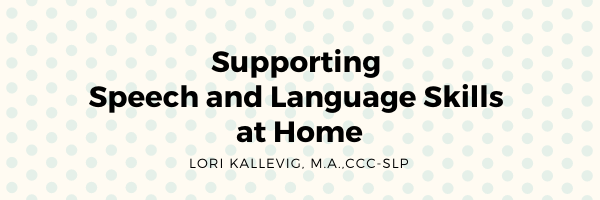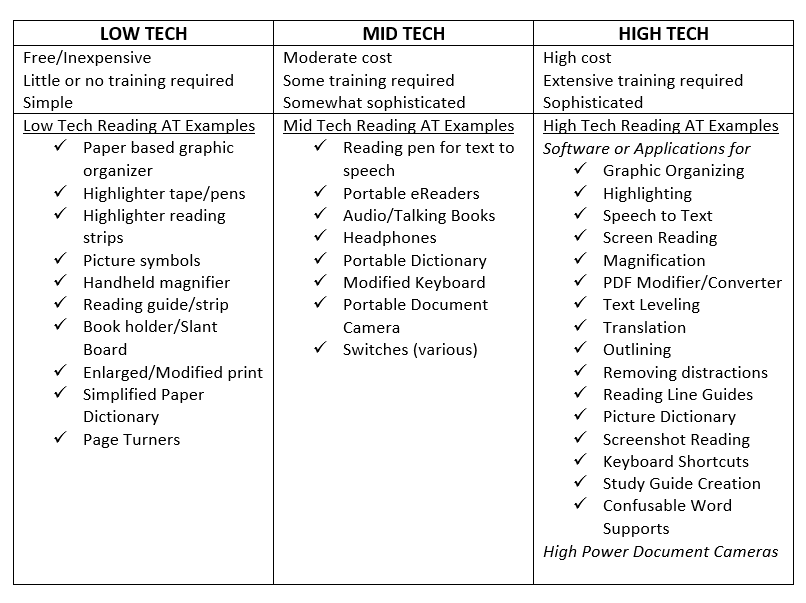Welcome to our Back-to-School Blog Series! This week, we are featuring a variety of professionals who are sharing their expertise to help make the back-to-school transition a little bit easier for students, parents, and educators. Today’s post has been written by Rebecca Guenther, MA, CCC-SLP, Amanda Stohrer, MS, OTR/L, ATP, and Laurene Sweet, PT, ATP, MEd, DPT from LeafBridge.
As we gather school supplies and prepare our students for the upcoming school year, it is important to review and understand your student’s IEP. Assistive Technology is an area commonly misunderstood or underrepresented on the IEP. Consideration of assistive technology needs is required by IDEA and is based on the unique educational needs of the student. In this blog, we review the meaning of assistive technology devices, team members involved in assistive technology services, and how to obtain an assistive technology evaluation/assessment.
What is AT and how can it help?
According to Section 300.5 of IDEA, assistive technology (AT) device means any item, piece of equipment, or product system, whether acquired commercially off the shelf, modified, or customized, that is used to increase, maintain, or improve the functional capabilities of a child with a disability. In simpler terms, an AT device levels the playing field to help a student with a disability function at the same or higher level. Some examples of assistive technology devices for education include Augmentative and Alternative Communication (AAC) devices, digital books with text to speech, adapted writing devices, a wheelchair, a switch accessible computer or tablet, and modifications for low vision just to name a few.
Where is AT listed in the IEP?
In section 2 of the IEP, there is a box probing the question “Does the child need assistive technology devices and/or services?” This should initiate a team discussion for justifying why a student would or would not benefit from AT devices and/or services. Parents, as a part of the IEP team, should be involved in conversations and decision making surrounding assistive technology. Through an Assistive Technology Evaluation, the team explores possible AT solutions in any number of areas such as reading, self-care, writing, computer access, learning, and math. If AT devices and services are warranted, each device or service should be specified under section 7 of the IEP.
What are Assistive Technology Services?
According to Section 300.6 of IDEA, assistive technology (AT) service means any service that directly assists a child with a disability in the selection, acquisition, or use of an assistive technology device. The term includes the evaluation of need, acquiring equipment, customizing and maintaining the equipment, coordinating with the IEP team, as well as training for the student and any other members of the student’s intervention team. Quality Indicators for Assistive Technology (QIAT), developed by focus groups and validated through research, indicates that “assistive technology assessments are conducted by a team with collective knowledge and skills”. Potential AT team members include parents, students, physical, occupational, and speech & language pathologists; intervention specialists; nurses; psychologists; vision specialists; and behavior specialists, just to name a few. No single specialist can be the expert across all areas of AT. Extensive resources are available on the QIAT website, including specific information about AT and the IEP process: https://qiat.org/indicators.html. Due to the ever-changing standards and availability of assistive technology, it may also be beneficial to include a RESNA certified Assistive Technology Professional (ATP) as a part of the IEP team. RESNA stands for Rehabilitation Engineering and Assistive Technology Society of North America. You can identify a RESNA certified ATP in your area using the “Find a Certified AT Professional Tool” at https://www.resna.org/. You may also order a copy of RESNA standards for Assistive Technology on the RESNA website: https://www.resna.org/at-standards.
How do I request an AT assessment?
Referral to initiate the AT process typically comes from concern by an educational professional and/or a parent or team discussion about a student’s needs. The concern typically surrounds area of the student’s educational program in which he/she is unable to participate due to his/her disability. The following is a good resource from OCALI with information about initiating the AT process: https://www.ocali.org/up_doc/AT_Resource_Guide_5.pdf. It is helpful for parents to submit requests in writing, clearly stating the request and the reason for the request. The following resource from the Georgia Project for Assistive Technology includes legal mandates for Assistive Technology: http://www.gpat.org/Georgia-Project-for-Assistive-Technology/Pages/Legal-Mandates-for-Assistive-Technology.aspx.
Summary
IDEA 2004 requires that the IEP team consider the assistive technology needs of every child with a disability. Consideration for AT supports should be a thorough evaluation process completed by a team of professionals in order to asses AT needs across all content areas. Look for our next blog to learn more about assistive technology for reading.
About the Authors
Rebecca Guenther, M.A, CCC-SLP is a speech-language pathologist with 14 years of school based, home and outpatient experience with a primary focus on children with complex disorders including cerebral palsy, autism, and rare genetic conditions. Rebecca has a passion for developing and implementing functional communication systems using a combination of both low and high technology augmentative/alternative communication systems. Rebecca is a leader in her field and has provided hands on training and professional in-services to her peers regarding Augmentative/Alternative Communication. Rebecca remains current in this ever-changing assistive technology field by attending professional conferences such as the Assistive Technology Industry Association Conference and Closing the Gap. Rebecca is proficient in programming multiple AAC devices from frequently used vendors such as Saltillo, Prentke Romich Company, Tobii-Dynavox, Pragmatic Organization Dynamic Display communication books, and multiple tablet applications. Rebecca serves as the Speech and Language Pathology Manager for the pediatric department at LeafBridge of United Cerebral Palsy (UCP) of Greater Cleveland. As manager, she coordinates speech therapy programming, leads Camp LeafBridge for Extended School Year summer programming and she coordinates feeding therapy services provided at LeafBridge. Rebecca travels the state of Ohio to conduct Assistive Technology Evaluations and Independent Educational Evaluations.
Amanda Stohrer, MS, OTR/L, ATP is an Occupational Therapist with extensive experience in providing care for children with complex disabilities. Amanda serves as the Occupational Therapy Manager for the pediatric department at LeafBridge of United Cerebral Palsy (UCP) of Greater Cleveland. As manager, Amanda coordinates occupational therapy programming for school-based services, outpatient therapies, fieldwork experiences, a functional skills program, upper extremity serial casting, and the LeafBridge Steps to Independence program for intensive intervention. Amanda is a RESNA certified Assistive Technology Professional and is highly skilled with transdisciplinary assessment for seating and mobility in collaboration with the assistive technology team at LeafBridge. Amanda earned a BS in Interdisciplinary Health Sciences in 2008 and then a master’s degree in Occupational Therapy in 2009 through Western Michigan University. Amanda has significant training in sensory integration, NDT, functional electrical stimulation, orthopedics, interventions for children with complex learning needs, and Cortical Visual Impairment (CVI.) As an adjunct faculty member for the COTA program at Cuyahoga Community College, Amanda facilitates the lab and lecture series for the course entitled "Techniques in Developmental Disabilities.” Amanda holds the Perkins-Roman CVI Range© Endorsement which demonstrates expertise in administering the CVI Range Assessment for Children with Cortical Visual Impairment. In addition, she earned Micro credentials in CVI Basics and the CVI Range. Amanda travels the state of Ohio to conduct Assistive Technology and Independent Educational Evaluations.
Laurene Sweet, PT, ATP, MEd, DPT is a Doctor of Physical Therapy and RESNA certified Assistive Technology Professional with 25 years of experience in outpatient clinics, schools, hospitals, an autism specialty program, and the Day Program for alternative school placements at UCP. She is the Manager of Specialized Services for LeafBridge. Laurene’s expertise in developing holistic programming for children with complex and co-existing disabilities emerged through cross training with other disciplines, continuing education, and direct experience. In 2007, she earned a master’s degree in Special Education with concentrations in Autism and Assistive Technology and advanced coursework in Functional Behavior Assessment. In 2014, Laurene published peer-reviewed clinical research in the Pediatric Physical therapy Journal. She manages the serial casting program at UCP to improve range of motion for children with ankle and foot deformities. Laurene coordinates UCP’s Day Program for children with complex learning needs and Cortical Visual Impairment (CVI). She holds the Perkins-Roman CVI Range© Endorsement which demonstrates expertise in administering the CVI Range Assessment for Children with Cortical Visual Impairment. In addition, Laurene earned Micro credentials in CVI Basics and the CVI Range. Laurene is a mother of a student with a Specific Learning Disability. She adopted two teenagers from foster care and is well-versed in Trauma Informed Care. Laurene travels the state of Ohio to conduct Assistive Technology and Independent Educational Evaluations.







